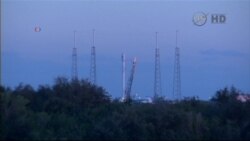A new satellite is traveling 1.5 million kilometers over a 110-day period to enter an orbit of the sun. It is called DSCOVR -- the Deep Space Climate Observatory. It will replace a satellite that has been observing space weather.
DSCOVR will begin its work during the worst of the 11-year-long solar cycle. This is a time when extreme weather on the sun can have the greatest effect on planet Earth.
DSCOVR will gather information about a continuing flow of particles from the sun. We are protected from these particles by the Earth’s magnetic field and atmosphere. But we are not fully protected from what scientists call Coronal Mass Ejections. These are strong storms that can happen on the sun’s surface.
Thomas Berger is the director of the Space Weather Prediction Center at the National Oceanic and Atmospheric Administration, or NOAA. He says these ejections are much more dangerous than solar particles. He says the Coronal Mass Ejections are extremely large magnetic clouds that are expelled from the sun at extremely high speeds. He says when they impact Earth, it is like a hurricane impacting Earth in terms of space weather.
Violent space weather can make electric systems stop working. It can block satellite signals to Earth. It can interfere with radio signals and air travel.
Mr. Berger says we cannot stop the ejections from affecting us, but we can prepare for them if we know when they will happen. When the DSCOVR satellite records an ejection, it will release a warning. Mr. Berger says the warning will provide NOAA about 15 to 60 minutes to let people know that a very strong storm is coming in to the Earth. He says that is enough time for power grid operators to take protective action. He says it is also enough time for workers to place satellites on a safe operating method if necessary.
Mr. Berger says scientists would like even more time, of course. He says researchers are developing instruments that will give an earlier warning.
The warnings from DSCOVR will be for the whole planet. But Mr. Berger says a new system may be able to give more-targeted warnings. He says future models will be able to tell exactly what part of the world will be more at risk from a solar storm.
That means that, for the first time, humans will get both a warning that a magnetic storm is heading towards Earth and information about where it is likely to hit.
I’m Marsha James.
Rosanne Skirble reported this story from Washington. Christopher Jones-Cruise wrote it for VOA Learning English. Caty Weaver was the editor.
_______________________________________________________________
Words in This Story
magnetic – adj. capable of being attracted by the properties of a magnet
ejection – n. the action of forcing or throwing something out
impact – v. to hit (something) with great force
hurricane – n. an extremely large, powerful, and destructive storm with very strong winds
grid – n. a metal frame with bars running across it that is used to cover an opening
Have you been affected by the sun’s storms? We want to hear from you. Write your thoughts in the comments section.






